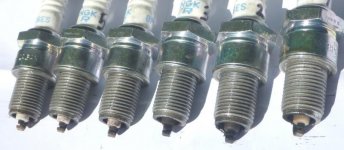Offline
Recently my #3 plug fouled. I replaced all the plugs and this is what they look like after a couple hundred miles or less:

Left to right #6 to #1
I'm thinking it's an issue with the wires, which are copper with the Moss screw-on bakelite ends.
The plugs are BPR6ES
Cylinder #5 is 145psi; the others are 155 - 165.
Any comments or suggestions?
Left to right #6 to #1
I'm thinking it's an issue with the wires, which are copper with the Moss screw-on bakelite ends.
The plugs are BPR6ES
Cylinder #5 is 145psi; the others are 155 - 165.
Any comments or suggestions?
Attachments
Last edited:

 Hi Guest!
Hi Guest!

 smilie in place of the real @
smilie in place of the real @
 Pretty Please - add it to our Events forum(s) and add to the calendar! >>
Pretty Please - add it to our Events forum(s) and add to the calendar! >> 




